Renovation Results of Finnish Single-Family Renovation Subsidies: Oil Boiler Replacement with Heat Pumps
Abstract
:1. Introduction
1.1. Finland’s Goal: Ending Fossil Fuel Oil Heating in Buildings
1.2. Finnish Energy Renovation Subsidies for Detached Buildings
1.3. Problem Setting and Research Questions
- What kind of actions has been taken in the renovated buildings?
- What has been the effect of renovation measures on the building’s energy consumption and power demand?
- Are the most popular renovation types likely to bring optimal results, or could the grant criteria be improved to encourage different renovation concepts?
2. Methods
2.1. Reference Building and Model Construction
- Detached house built from 1970 to 1979;
- Oil boiler as the main heating system;
- A fireplace present (typical for the period);
- Actual fuel consumption has been disclosed for oil, wood and electricity separately;
- The certificate was made according to the current (2018) version of the building code;
- Certificates or entries with obviously erroneous data have been disregarded.
2.2. Simulation Model
- Improved insulation of the roof (U = 0.22 to U = 0.09) and replacing the old windows with new (U = 1.8 to U = 0.8) (Cal + ENV);
- Improved insulation together with mechanical supply-exhaust with heat recovery (temp efficiency 0.8) (Cal + ENV + HRV);
- Air-to-water heat pump for radiator heating and domestic hot water production (AWHP);
- Improved insulation together with an air-to-water heat pump (AWHP + ENV);
- Improved insulation together with mechanical supply-exhaust with heat recovery and air-to-water heat pump (AWHP + ENV + HRV);
- Ground-source heat pump for radiator heating and domestic hot water production (GSHP);
- Improved insulation measure together with ground-source heat pump (GSHP + ENV);
- Improved insulation + mechanical supply exhaust with heat recovery and air-to-water heat pump (GSHP + ENV + HRV).
2.3. Renovation Grant Data
3. Results and Discussions
3.1. Overview of Granted Subsidies
3.2. Simulation Results of the Reference Building
4. Conclusions
- More emphasis should be placed on deep renovations instead of encouraging the cheapest renovation options. Subsidy amounts and admission requirements should be considered in this light, carefully recognizing the financial and other challenges many households face.
- The requirement to improve ventilation to an adequate level has been missing from grants and can be recommended to be required in the future to ensure adequate indoor air quality after renovation. In practical terms, this will mean installing heat recovery ventilation which brings additional benefits in terms of comfort and user satisfaction. When installing heat recovery ventilation, building air tightness may need improvement, if not additionally insulating, for the effective operation of the heat recovery.
- Replacement of oil boilers with heat pumps is already the most commonly subsidized renovation option. This yields significant energy savings, even larger in the case of ground-source heat pumps than in the case of air-to-water heat pumps. In light of this, ELY and ARA renovation grants help Finland in decarbonizing its building sector and also in reaching its climate targets, both on a national and EU level.
- Ground-source heat pumps demand less power than air-to-water heat pumps. Installing own solar PV production helps to supply part of the electricity required by the heat pump systems and even to achieve a yearly plus energy balance. This can be especially beneficial when electricity prices are rising steeply.
Author Contributions
Funding
Acknowledgments
Conflicts of Interest
References
- European Union Directive (EU). 2018/844 of the European Parliament. Off. J. Eur. Union 2018, 156. [Google Scholar]
- Directive 2010/31/EU of the European Parliament and of the Council. Directive 2010/31/EU of the European Parliament and of the Council of 19 May 2010 on the Energy Performance of Buildings; European Parliament and of the Council: London, UK, 2010; pp. 13–35.
- Gojak, M.; Bajc, T. Thermodynamic Sustainability Assessment for Residential Building Heating Comparing Different Energy Sources. Sci. Technol. Built Environ. 2022, 28, 73–83. [Google Scholar] [CrossRef]
- Karner, K.; Dißauer, C.; Enigl, M.; Strasser, C.; Schmid, E. Environmental Trade-Offs between Residential Oil-Fired and Wood Pellet Heating Systems: Forecast Scenarios for Austria until 2030. Renew. Sustain. Energy Rev. 2017, 80, 868–879. [Google Scholar] [CrossRef]
- Thomaßen, G.; Kavvadias, K.; Jiménez Navarro, J.P. The Decarbonisation of the EU Heating Sector through Electrification: A Parametric Analysis. Energy Policy 2021, 148, 111929. [Google Scholar] [CrossRef]
- Meadows, D.; Vis, P.; Zapfel, P. The Eu Emissions Trading System. In Towards a Climate-Neutral Europe: Curbing the Trend; Routledge: London, UK, 2019; pp. 66–94. ISBN 9781000750713. [Google Scholar]
- European Parliament. BRIEFING EU Legislation in Progress—Revising the Energy Efficiency Directive: Fit for 55 Package. Available online: https://epthinktank.eu/2021/09/30/revising-the-energy-efficiency-directive-fit-for-55-package-eu-legislation-in-progress (accessed on 30 September 2021).
- Schlacke, S.; Wentzien, H.; Thierjung, E.-M.; Köster, M. Implementing the EU Climate Law via the “Fit for 55” Package. Oxf. Open Energy 2022, 1. [Google Scholar] [CrossRef]
- Tognetti, F. Analysis of Existing Incentives in Europe for Heating Powered by Fossil Fuels and Renewable Sources. Brussels, BE Eur. Environ. Bur. 2020, 40. [Google Scholar]
- Finnish Ministry of the Environment. Fossiilisesta öljylämmityksestä luopumisen toimenpideohjelma. Luonnos./Operational Program for Ending Fossil Oil Heating. Available online: https://www.lausuntopalvelu.fi/FI/Proposal/DownloadProposalAttachment?attachmentId=15521 (accessed on 30 August 2022).
- Finnish Ministry of the Environment. Valtioneuvoston asetus asuinrakennusten energia-avustuksista vuosille 2020–2022. Muistio 11.12.2019./Governmental Degree on Residential Building Energy Renovation Subsidies for 2020–2022. Memo 11.12.2019. Available online: https://valtioneuvosto.fi/delegate/file/65619 (accessed on 30 August 2022).
- Crawley, J.; Manouseli, D.; Mallaburn, P.; Elwell, C. An Empirical Energy Demand Flexibility Metric for Residential Properties. Energies 2022, 15, 5304. [Google Scholar] [CrossRef]
- Carella, A.; D’Orazio, A. The Heat Pumps for Better Urban Air Quality. Sustain. Cities Soc. 2021, 75, 103314. [Google Scholar] [CrossRef]
- Ancona, M.A.; Baldi, F.; Branchini, L.; De Pascale, A.; Gianaroli, F.; Melino, F.; Ricci, M. Comparative Analysis of Renewable Energy Community Designs for District Heating Networks: Case Study of Corticella (Italy). Energies 2022, 15, 5248. [Google Scholar] [CrossRef]
- Minuto, F.D.; Lazzeroni, P.; Borchiellini, R.; Olivero, S.; Bottaccioli, L.; Lanzini, A. Modeling Technology Retrofit Scenarios for the Conversion of Condominium into an Energy Community: An Italian Case Study. J. Clean. Prod. 2021, 282, 124536. [Google Scholar] [CrossRef]
- Stamatellos, G.; Zogou, O.; Stamatelos, A. Energy Performance Optimization of a House with Grid-Connected Rooftop PV Installation and Air Source Heat Pump. Energies 2021, 14, 740. [Google Scholar] [CrossRef]
- Zator, S.; Skomudek, W. Impact of DSM on Energy Management in a Single-Family House with a Heat Pump and Photovoltaic Installation. Energies 2020, 13, 5476. [Google Scholar] [CrossRef]
- Jadwiszczak, P.; Jurasz, J.; Kaźmierczak, B.; Niemierka, E.; Zheng, W. Factors Shaping A/W Heat Pumps CO₂ Emissions—Evidence from Poland. Energies 2021, 14, 1576. [Google Scholar] [CrossRef]
- Chomać-Pierzecka, E.; Sobczak, A.; Soboń, D. The Potential and Development of the Geothermal Energy Market in Poland and the Baltic States—Selected Aspects. Energies 2022, 15, 4142. [Google Scholar] [CrossRef]
- Ochs, F.; Monteleone, W.; Dermentzis, G.; Siegele, D.; Speer, C. Compact Decentral Façade-Integrated Air-to-Air Heat Pumps for Serial Renovation of Multi-Apartment Buildings. Energies 2022, 15, 4679. [Google Scholar] [CrossRef]
- Montero, O.; Brischoux, P.; Callegari, S.; Fraga, C.; Rüetschi, M.; Vionnet, E.; Calame, N.; Rognon, F.; Patel, M.; Hollmuller, P. Large Air-to-Water Heat Pumps for Fuel-Boiler Substitution in Non-Retrofitted Multi-Family Buildings—Energy Performance, CO2 Savings, and Lessons Learned in Actual Conditions of Use. Energies 2022, 15, 5033. [Google Scholar] [CrossRef]
- Conrad, J.; Greif, S. Modelling Load Profiles of Heat Pumps. Energies 2019, 12, 766. [Google Scholar] [CrossRef] [Green Version]
- Finnish ELY-Centre. Avustus pientalon öljylämmityksestä luopumiseksi./Grant for Replacing Oil Heating in a Detached House. Centre for Economic Development, Transport and the Environment (ELY-Centre). Available online: https://www.ely-keskus.fi/oljylammityksen-vaihtajalle (accessed on 30 August 2022).
- Vimpari, J. Should Energy Efficiency Subsidies Be Tied into Housing Prices? Environ. Res. Lett. 2021, 16, 064027. [Google Scholar] [CrossRef]
- Pikas, E.; Kurnitski, J.; Liias, R.; Thalfeldt, M. Quantification of Economic Benefits of Renovation of Apartment Buildings as a Basis for Cost Optimal 2030 Energy Efficiency Strategies. Energy Build. 2015, 86, 151–160. [Google Scholar] [CrossRef]
- Lihtmaa, L.; Hess, D.B.; Leetmaa, K. Intersection of the Global Climate Agenda with Regional Development: Unequal Distribution of Energy Efficiency-Based Renovation Subsidies for Apartment Buildings. Energy Policy 2018, 119, 327–338. [Google Scholar] [CrossRef]
- Mikola, A.; Hamburg, A.; Kuusk, K.; Kalamees, T.; Voll, H.; Kurnitski, J. The Impact of the Technical Requirements of the Renovation Grant on the Ventilation and Indoor Air Quality in Apartment Buildings. Build. Environ. 2022, 210, 108698. [Google Scholar] [CrossRef]
- Hamburg, A.; Kuusk, K.; Mikola, A.; Kalamees, T. Realisation of Energy Performance Targets of an Old Apartment Building Renovated to nZEB. Energy 2020, 194, 116874. [Google Scholar] [CrossRef]
- Kuusk, K.; Kalamees, T. Estonian Grant Scheme for Renovating Apartment Buildings. Energy Procedia 2016, 96, 628–637. [Google Scholar] [CrossRef] [Green Version]
- Hamburg, A.; Kalamees, T. Improving the indoor climate and energy saving in renovated apartment buildings in Estonia. In Proceedings of the Cold Climate HVAC 2018 Conference, Kiruna, Sweden, 12–15 March 2018; pp. 243–251. [Google Scholar]
- Lihtmaa, L.; Kalamees, T. Preliminary assessment of preconditions to deliver carbon neutrality in apartment buildings by 2050. In Proceedings of the E3S Web of Conferences, 12th Nordic Symposium on Building Physics (NSB 2020), Tallinn, Estonia, 7–9 September 2020; Volume 172. [Google Scholar]
- Finnish Ministry of the Environment. Energiatehokkuutta Koskevien Vähimmäisvaatimusten Kustannusoptimaalisten Tasojen Laskenta, Finnish Cost Optimal Report; Finnish Ministry of the Environment: Finland, 2012.
- Sahlin, P.; Eriksson, L.; Grozman, P.; Johnsson, H.; Shapovalov, A.; Vuolle, M. Whole-Building Simulation with Symbolic DAE Equations and General Purpose Solvers. Build. Environ. 2004, 39, 949–958. [Google Scholar] [CrossRef]
- Achermann, M.; Zweifel, G. RADTEST—Radiant Heating and Cooling Test Cases. Evaluation 2003, 93. [Google Scholar]
- Loutzenhiser, P.G.; Maxwell, G.M.; Manz, H. An Empirical Validation of the Daylighting Algorithms and Associated Interactions in Building Energy Simulation Programs Using Various Shading Devices and Windows. Energy 2007, 32, 1855–1870. [Google Scholar] [CrossRef]
- Salvalai, G. Implementation and Validation of Simplified Heat Pump Model in IDA-ICE Energy Simulation Environment. Energy Build. 2012, 49, 132–141. [Google Scholar] [CrossRef]
- Hilliaho, K.; Lahdensivu, J.; Vinha, J. Glazed Space Thermal Simulation with IDA-ICE 4.61 Software - Suitability Analysis with Case Study. Energy Build. 2015, 89, 132–141. [Google Scholar] [CrossRef]
- Mazzeo, D.; Matera, N.; Cornaro, C.; Oliveti, G.; Romagnoni, P.; De Santoli, L. EnergyPlus, IDA ICE and TRNSYS Predictive Simulation Accuracy for Building Thermal Behaviour Evaluation by Using an Experimental Campaign in Solar Test Boxes with and without a PCM Module. Energy Build. 2020, 212, 109812. [Google Scholar] [CrossRef]
- Ferrantelli, A.; Ahmed, K.; Pylsy, P.; Kurnitski, J. Analytical Modelling and Prediction Formulas for Domestic Hot Water Consumption in Residential Finnish Apartments. Energy Build. 2017, 143, 53–60. [Google Scholar] [CrossRef]
- Ahmed, K.; Fadejev, J.; Kurnitski, J. Modeling an Alternate Operational Ground Source Heat Pump for Combined Space Heating and Domestic Hot Water Power Sizing. Energies 2019, 12, 2120. [Google Scholar] [CrossRef] [Green Version]
- Mikola, A.; Kalamees, T.; Kõiv, T.A. Performance of Ventilation in Estonian Apartment Buildings. Energy Procedia 2017, 132, 963–968. [Google Scholar] [CrossRef]
- D’Agostino, D.; Mele, L.; Minichiello, F.; Renno, C. The Use of Ground Source Heat Pump to Achieve a Net Zero Energy Building. Energies 2020, 13, 3450. [Google Scholar] [CrossRef]
- D’agostino, D.; Esposito, M.; Minichiello, F.; Renno, C. Feasibility Study on the Spread of Nzebs Using Economic Incentives. Energies 2021, 14, 7169. [Google Scholar] [CrossRef]
- Finnish Ministry of the Environment. Rakennusten energiatehokkuuden parantamisen osoittaminen energia-avustushankkeissa. Available online: https://www.ymparisto.fi/download/Laskentaohje_asuinrakennusten_energiaavustus_812020pdf/%7BA961ECE3-3C1C-4C07-B3BB-AC4F5FCB1EEE%7D/154371 (accessed on 30 August 2022).
- Abid, M.; Hewitt, N.; Huang, M.J.; Wilson, C.; Cotter, D. Performance Analysis of the Developed Air Source Heat Pump System at Low-to-Medium and High Supply Temperatures for Irish Housing Stock Heat Load Applications. Sustainability 2021, 13, 11753. [Google Scholar] [CrossRef]
- Fadejev, J.; Simson, R.; Kurnitski, J.; Kesti, J.; Mononen, T.; Lautso, P. Geothermal Heat Pump Plant Performance in a Nearly Zero-Energy Building. Energy Procedia 2016, 96, 489–502. [Google Scholar] [CrossRef]
- Fadejev, J.; Simson, R.; Kurnitski, J.; Haghighat, F. A Review on Energy Piles Design, Sizing and Modelling. Energy 2017, 122, 390–407. [Google Scholar] [CrossRef]
- Di Schio, E.R.; Ballerini, V.; Dongellini, M.; Valdiserri, P. Defrosting of Air-Source Heat Pumps: Effect of Real Temperature Data on Seasonal Energy Performance for Different Locations in Italy. Appl. Sci. 2021, 11, 8003. [Google Scholar] [CrossRef]

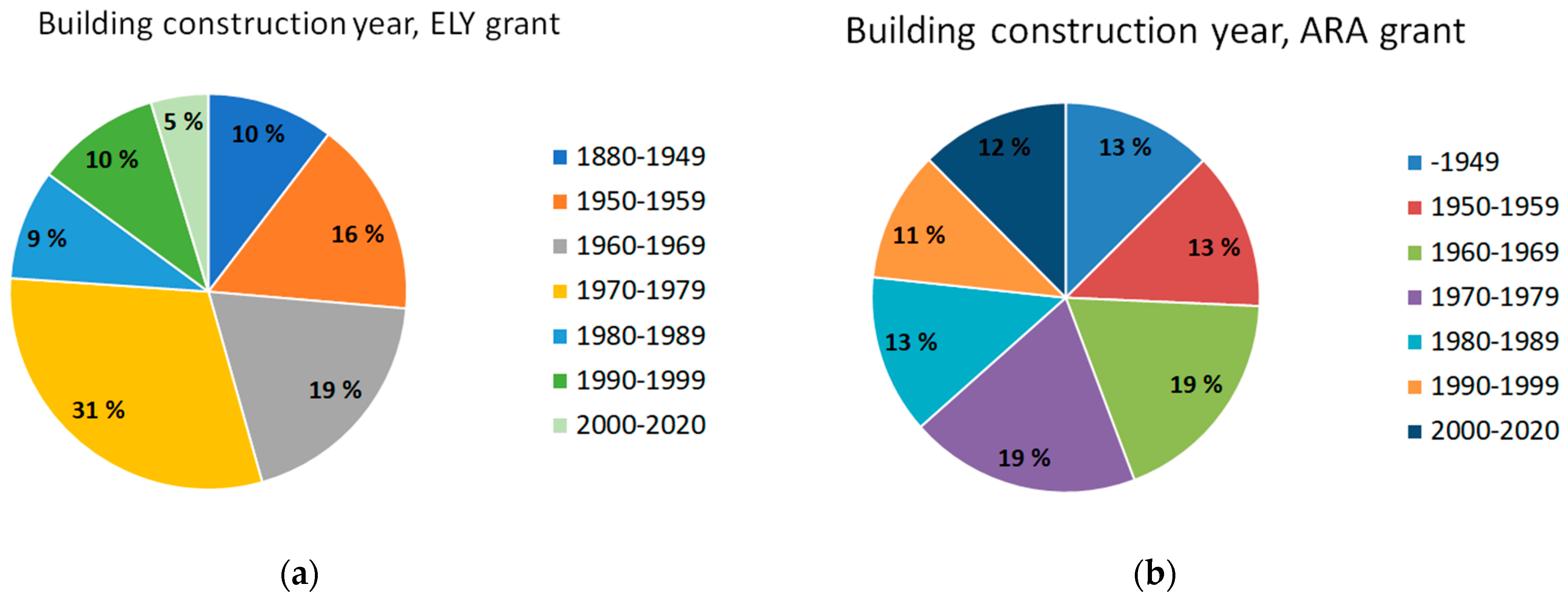
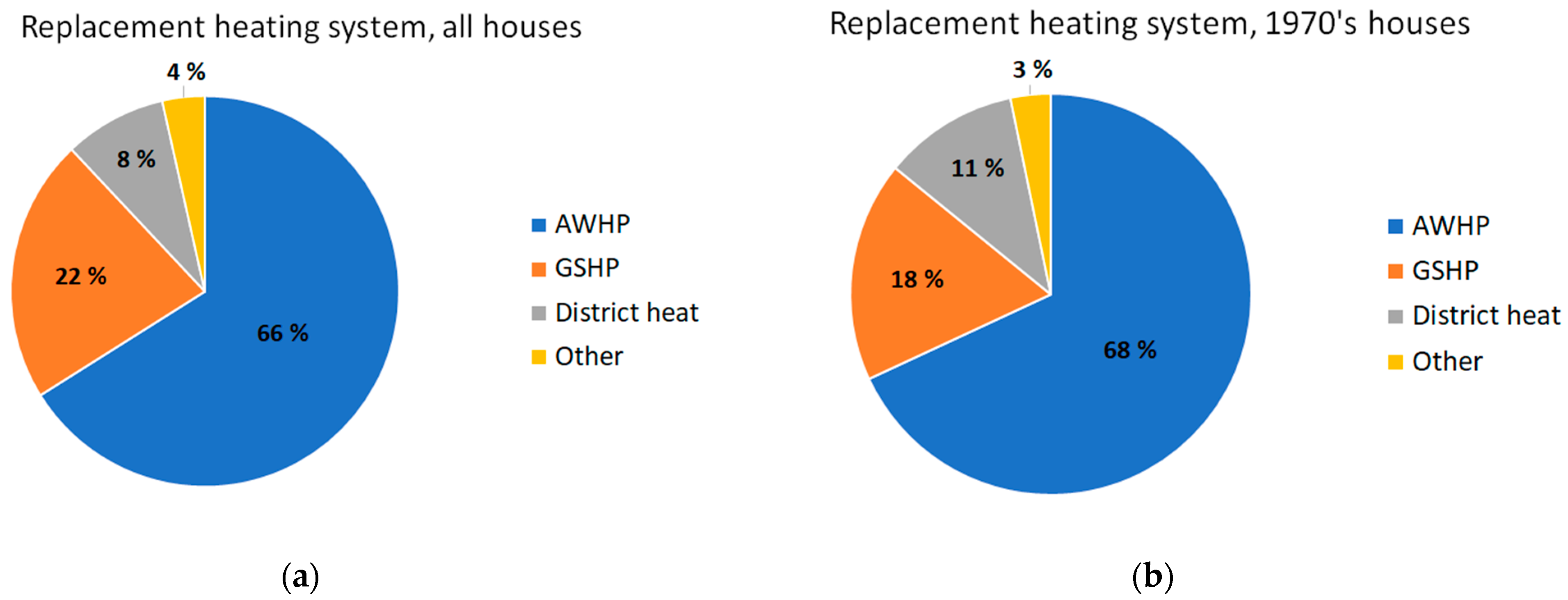

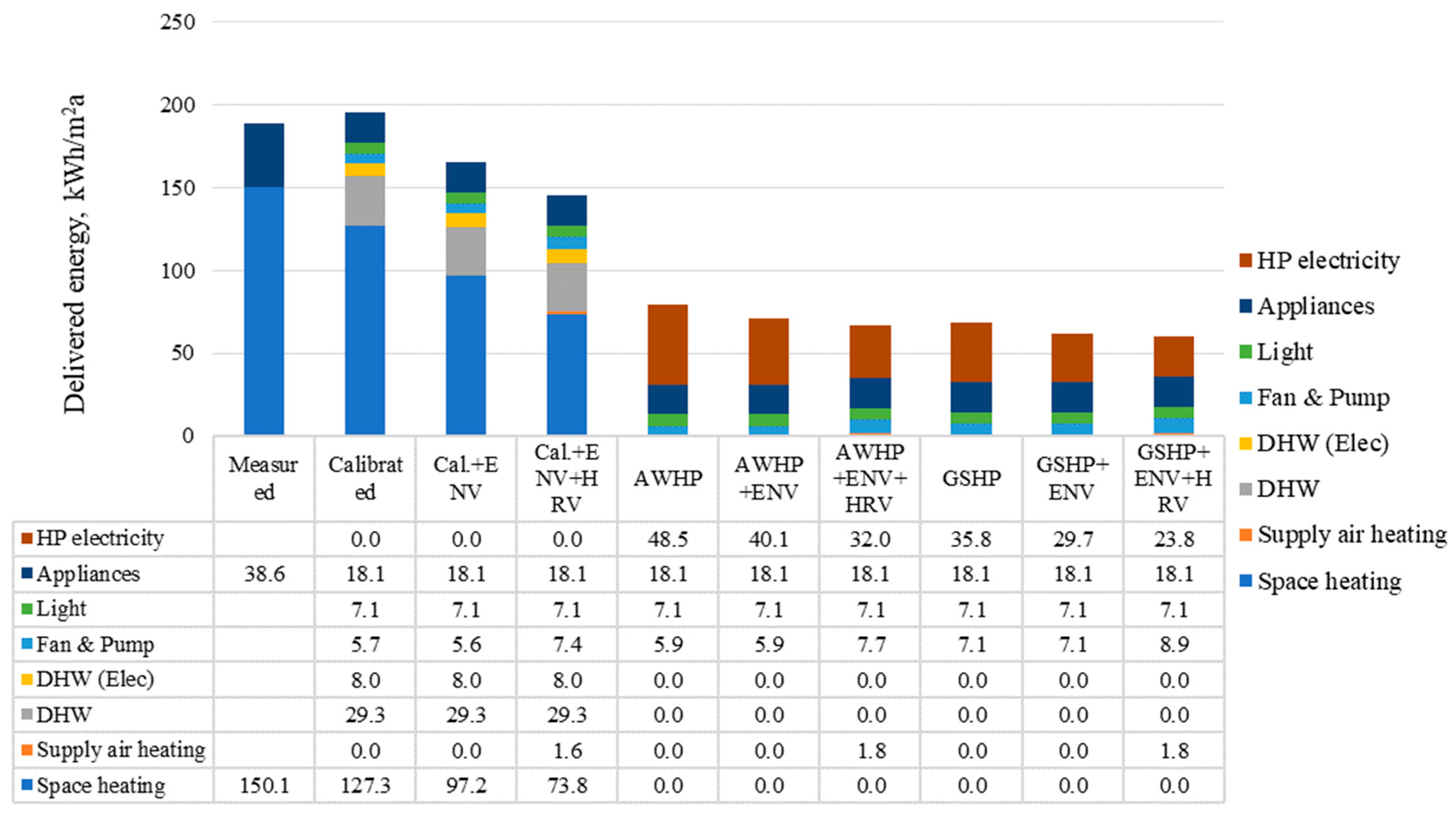
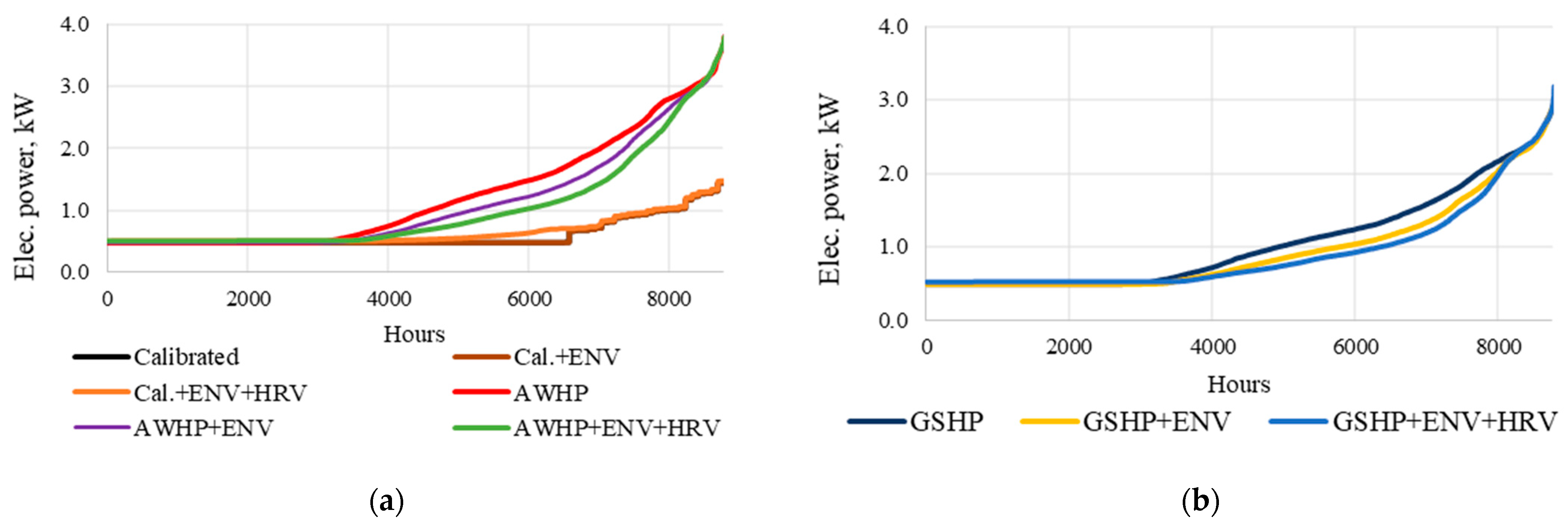

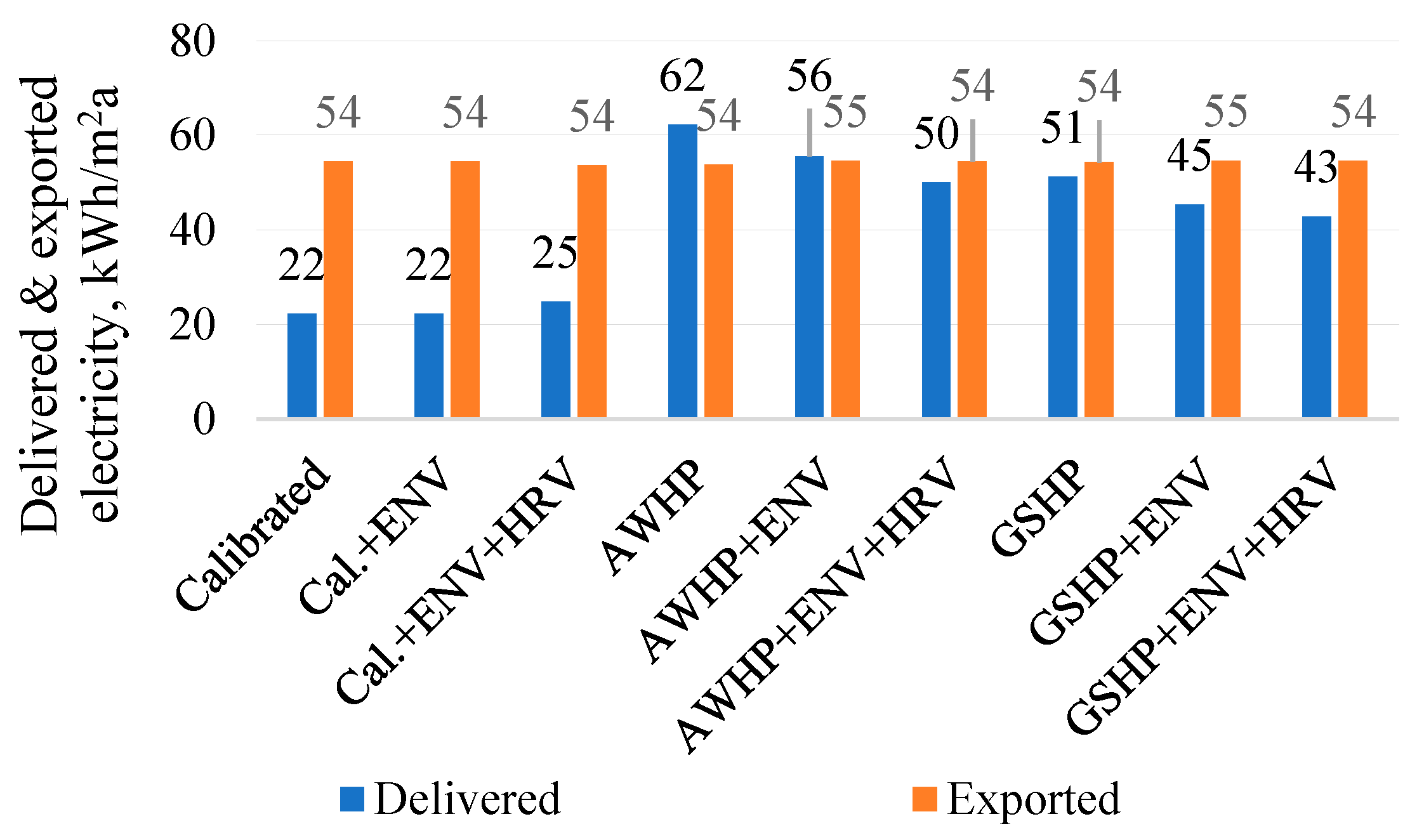
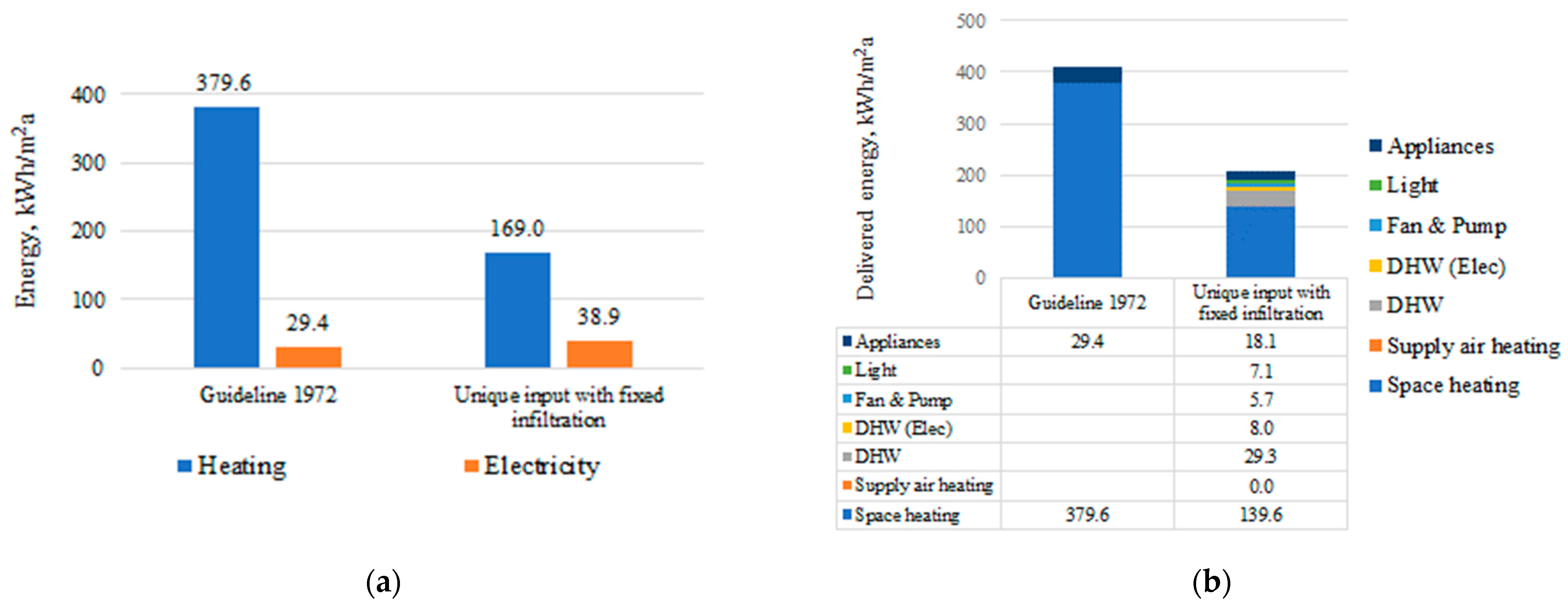


| Main Properties of the Selected Houses | Value | |
|---|---|---|
| Average | Median | |
| Wood consumption, kWh/a | 4729.6 | 3900.0 |
| Wood consumption, kWh/m2a | 34.9 | 26.9 |
| Fuel oil consumption, kWh/a | 18,750.0 | 20,000.0 |
| Fuel oil consumption, kWh/m2a | 128.4 | 123.2 |
| Fuel oil consumption, L/a | 1875.0 | 2000.0 |
| Fuel oil consumption, L/m2a | 12.8 | 12.3 |
| Actual electricity consumption, kWh/a | 6566.2 | 5550.0 |
| Actual electricity consumption, kWh/m2a | 44.2 | 38.6 |
| Heated net area, m2 | 153.8 | 129.0 |
| Parameter | Value |
|---|---|
| Air tightness q50, m3/(m2h) | 5.11 |
| U-value external walls, W/(m2K) | 0.3 |
| U-value roof, W/(m2K) | 0.18 |
| U-value base floor, W/(m2K) | 0.31 |
| U-value windows, W/(m2K) | 1.80 |
| Area windows, m2 | 19.74 |
| Boiler efficiency, - | 0.81 |
| Heat distribution efficiency, - | 0.85 |
| Calibrated | Cal. + ENV | Cal. + ENV + HRV | AWHP | AWHP + ENV | AWHP + ENV + HRV | GSHP | GSHP + ENV | GSHP + ENV + HRV | |
|---|---|---|---|---|---|---|---|---|---|
| Power (95 percentile), kW | 1.2 | 1.2 | 1.3 | 3.0 | 2.9 | 2.9 | 2.3 | 2.3 | 2.3 |
| Power (95 percentile), W/m2 | 9.0 | 9.0 | 9.2 | 22.0 | 21.5 | 21.4 | 17.2 | 16.9 | 17.2 |
| Power (99 percentile), kW | 1.4 | 1.4 | 1.5 | 3.5 | 3.5 | 3.5 | 2.8 | 2.7 | 2.7 |
| Power (99 percentile), W/m2 | 10.6 | 10.6 | 10.8 | 25.4 | 25.6 | 25.5 | 20.2 | 20.1 | 20.1 |
| Power (100 percentile), kW | 1.4 | 1.4 | 1.5 | 3.8 | 3.8 | 3.8 | 3.0 | 3.0 | 3.2 |
| Calibrated | Cal. + ENV | Cal. + ENV + HRV | AWHP | AWHP + ENV | AWHP + ENV + HRV | GSHP | GSHP + ENV | GSHP + ENV + HRV | |
|---|---|---|---|---|---|---|---|---|---|
| Elec. use, kWh/m2a | 39 | 39 | 42 | 79 | 72 | 67 | 68 | 62 | 59 |
| Delivered, kWh/m2a | 22 | 22 | 25 | 62 | 56 | 50 | 51 | 45 | 43 |
| Exported, kWh/m2a | 54 | 54 | 54 | 54 | 55 | 54 | 54 | 55 | 54 |
| PV production, kWh/m2a | 71 | 71 | 71 | 71 | 71 | 71 | 71 | 71 | 71 |
| Self-use, % | 23.4 | 23.4 | 24.4 | 24.3 | 23.1 | 23.3 | 23.5 | 23.0 | 23.2 |
| AWHP | AWHP + ENV | AWHP + ENV + HRV | GSHP | GSHP + ENV | GSHP +ENV + HRV | |
|---|---|---|---|---|---|---|
| SH + DHW | 2.49 | 2.49 | 2.48 | 3.32 | 3.33 | 3.31 |
| DHW | 2.48 | 2.45 | 2.41 | 3.13 | 3.12 | 3.11 |
| SH | 2.50 | 2.54 | 2.59 | 3.43 | 3.54 | 3.62 |
Publisher’s Note: MDPI stays neutral with regard to jurisdictional claims in published maps and institutional affiliations. |
© 2022 by the authors. Licensee MDPI, Basel, Switzerland. This article is an open access article distributed under the terms and conditions of the Creative Commons Attribution (CC BY) license (https://creativecommons.org/licenses/by/4.0/).
Share and Cite
Sankelo, P.; Ahmed, K.; Mikola, A.; Kurnitski, J. Renovation Results of Finnish Single-Family Renovation Subsidies: Oil Boiler Replacement with Heat Pumps. Energies 2022, 15, 7620. https://doi.org/10.3390/en15207620
Sankelo P, Ahmed K, Mikola A, Kurnitski J. Renovation Results of Finnish Single-Family Renovation Subsidies: Oil Boiler Replacement with Heat Pumps. Energies. 2022; 15(20):7620. https://doi.org/10.3390/en15207620
Chicago/Turabian StyleSankelo, Paula, Kaiser Ahmed, Alo Mikola, and Jarek Kurnitski. 2022. "Renovation Results of Finnish Single-Family Renovation Subsidies: Oil Boiler Replacement with Heat Pumps" Energies 15, no. 20: 7620. https://doi.org/10.3390/en15207620






